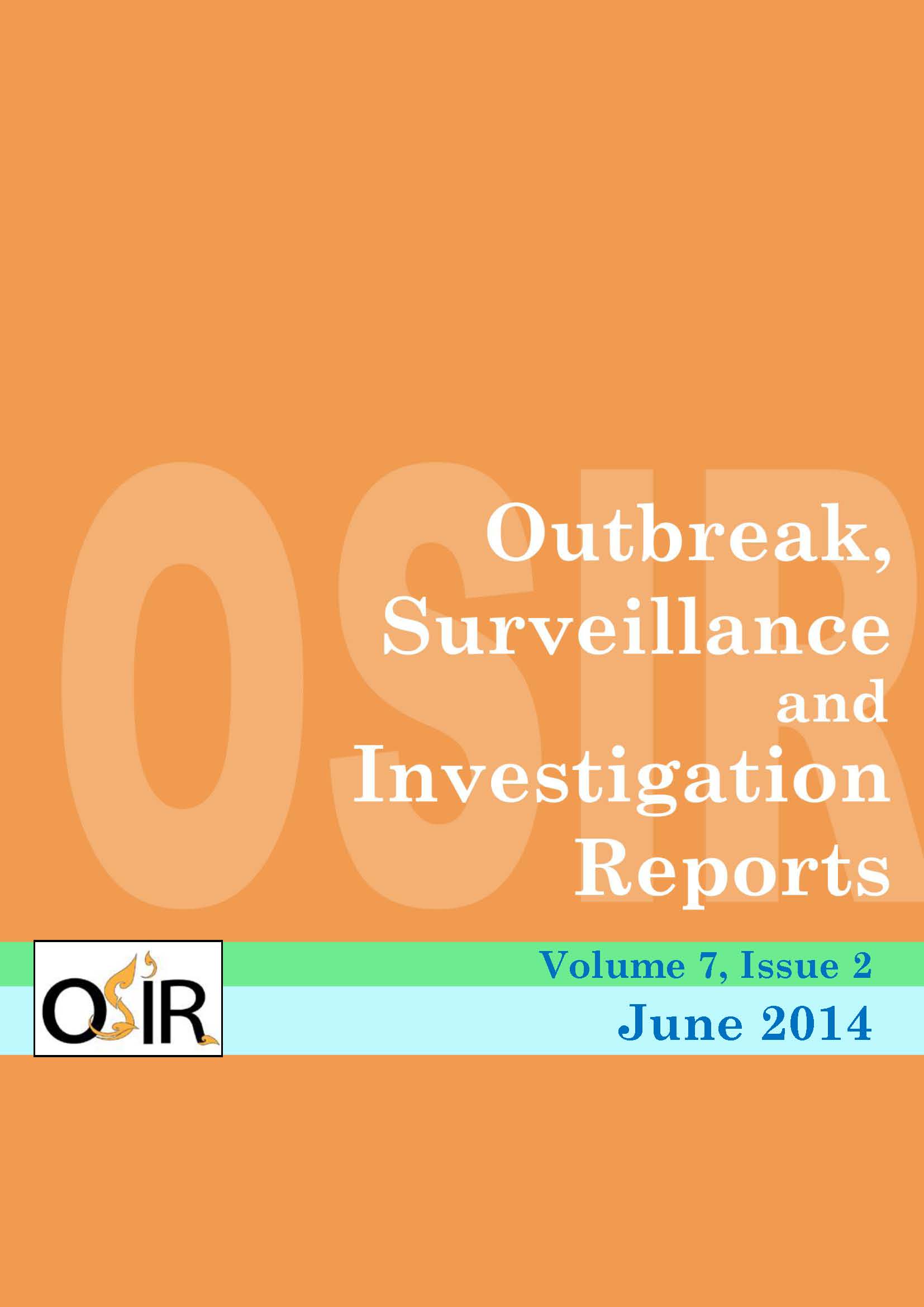Epidemiology of Leptospirosis from Thai National Disease Surveillance System, 2003-2012
DOI:
https://doi.org/10.59096/osir.v7i2.263289Keywords:
leptospirosis, epidemiology, mortality determinants, ThailandAbstract
Leptospirosis is a major public health problem in Thailand. A description on epidemiology of the disease could increase understanding of leptospirosis and suggest potential prevention and control measures. Data on human leptospirosis cases from all 77 provinces in Thailand were collected based on the national surveillance criteria. Univariate analysis and multiple logistic regression were conducted to describe occurrence of leptospirosis cases and risk factors for mortality. From 2003 to 2012, there were 41,089 cases of leptospirosis reported to Bureau of Epidemiology, Ministry of Public Health, Thailand. Average annual incidence rate was 6.6 per 100,000 population. Northeastern region showed the highest incidence (12.5 per 100,000 population). There were 606 deaths, with case fatality rate 1.5%. Seasonal variation was observed, with the highest incidence during rainy season from August to October. Ratio of male to female cases was 3.5:1. Adults aged 55-64 years had the highest incidence rate (9.9 per 100,000 population). There were 72.3% of the cases that worked in agricultural sector. Delay in seeking treatment, which was beyond three days after onset, significantly increased the risk of death (adjusted odds ratio = 1.8, 95% CI = 1.53-2.19).
References
World Health Organization. Human leptospirosis: guidance for diagnosis, surveillance and control. Malta: World Health Organization; 2003 [cited 2012 Aug 5]. <http://whqlibdoc.who.int/hq/2003/WHO_CDS_CSR_EPH_2002.23.pdf>
Levett PN. Leptospirosis. Clin Microbiol Rev. 2001 Apr;14(2):296-326.
Suwancharoen D, Hinjoy S, Fungladda W, Yoshida S. Serological survey of livestock leptospirosis in rural community, Nakhon Ratchsima, Thailand, 2004. J Thai Vet Med Assoc. 2013;65:1-12.
Regional Office for South-East Asia. World Health Organization. Fact sheet: leptospirosis [cited 2014 Apr 6]. <http://www.searo.who.int/about/administration_structure/cds/CDS_leptospirosis-Fact_Sheet.pdf>
Center for Food Security and Public Health. Leptospirosis. 2013 Oct [cited 2014 Apr 21]. <http://www.cfsph.iastate.edu/Factsheets/pdfs/leptospirosis.pdf>
Thailand. Bureau of Epidemiology. Department of Disease Control. Ministry of Public Health. Annual epidemiology surveillance report 1993-2000. Bangkok: Ministry of Public Health Thailand; 2000.
Kuharat S. Case definition for communicable disease surveillance. 2001 [cited 2012 Aug 8]. <http://203.157.15.6/ktext/cdsur/home.htm>
Centers for Disease Control and Prevention. Epi Info [cited 2014 Apr 23]. <http://wwwn.cdc.gov/epiinfo/html/prevVersion.htm>
Wangroongsarb P, Petkanchanapong W, Yasaeng S, Imvithaya A, Naigowit P. Survey of leptospirosis among rodents in epidemic areas of Thailand. J Trop Med Parasitol. 2002;25:55-8.
Thaipadungpanit J, Wuthiekanun V, Chierakul W, Smythe LD, Petkanchanapong W, Limpaiboon R, et al. A dominant clone of Leptospira interrogans associated with an outbreak of human leptospirosis in Thailand. PLoS Negl Trop Dis. 2007 Oct 31;1(1):e56.
Rubber Research Institute of Thailand [cited 2014 Apr 23]. <http://www.rubberthai.com>
Gaynor K, Katz AR, Park SY, Nakata M, Clark TA, Effler PV. Leptospirosis on Oahu: an outbreak associated with flooding of a university campus. Am J Trop Med Hyg. 2007 May;76(5):882-5.
Johnson MAS, Smith H, Joseph P, Gilman RH, Bautista CT, Campos KJ, et al. Environmental exposure and leptospirosis, Peru. Emerg Infect Dis. 2004 Jun;10(6):1016-22.
Chauhan V, Mahesh DM, Panda P, Mokta J, Thakur S. Profile of patients of leptospirosis in sub-Himalayan region of North India. J Assoc Physicians India. 2010;58: 354-6.
Thai Meteorological Department. The weather in Thailand. 2007 [cited 2012 Aug 5]. <http://www.tmd.go.th/info/info.php?FileID=53>
Perez J, Brescia F, Becam J, Mauron C, Goarant C. Rodent abundance dynamics and leptospirosis carriage in an area of hyper-endemicity in New Caledonia. PLoS Negl Trop Dis. 2011 Oct;5(10):e1361. Epub 2011 Oct 25.
Everard CO, Hayes RJ, Fraser-Chanpong GM. A serosurvey for leptospirosis in Trinidad among urban and rural dwellers and persons occupationally at risk. Trans R Soc Trop Med Hyg. 1985;79(1):96-105.
Waitkins SA. Leptospirosis as an occupational disease. Br J Ind Med. 1986 Nov;43(11):721-5.
Bruce MG, Sanders EJ, Leake JA, Zaidel O, Bragg SL, Aye T, et al. Leptospirosis among patients presenting with dengue-like illness in Puerto Rico. Acta Trop. 2005 Oct;96(1):36-46.
Kawaguchi L, Sengkeopraseuth B, Tsuyuoka R, Koizumi N, Akashi H, Vongphrachanh P, et al. Seroprevalence of leptospirosis and risk factor analysis in flood-prone rural areas in Lao PDR. Am J Trop Med Hyg. 2008 Jun;78(6):957-61.
Ittyachen AM, Krishnapillai TV, Nair MC, Rajan AR. Retrospective study of severe cases of leptospirosis admitted in the intensive care unit. J Postgrad Med. 2007 Oct-Dec;53(4):232-5.
World Health Organization. Human leptospirosis: guidance for diagnosis, surveillance and control. Malta: World Health Organization; 2003.
Lau C, Smythe L, Weinstein P. Leptospirosis: an emerging disease in travellers. Travel Med Infect Dis. 2010 Jan;8(1):33-9. Epub 2010 Jan 6.
Downloads
Published
How to Cite
Issue
Section
License
Copyright (c) 2023 Outbreak, Surveillance, Investigation & Response (OSIR) Journal

This work is licensed under a Creative Commons Attribution-NonCommercial-NoDerivatives 4.0 International License.









